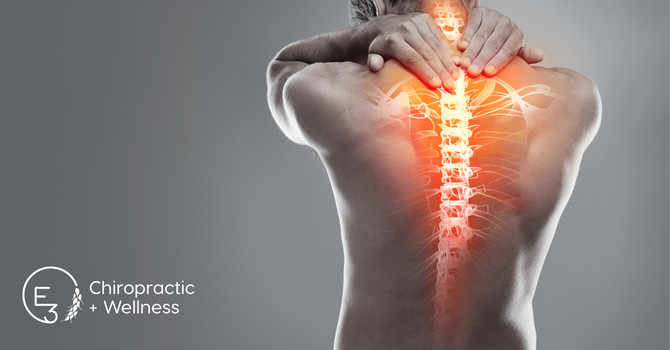Low back pain is one of the most common musculoskeletal issues troubling Canadians
Statistics show that 80% of the population will suffer from a low back condition at least once in their lifetime.
Low back pain is a general term, and many conditions can be the culprit for causing pain in the lower back, hips and sciatica-type pain.
What's causing your low back pain?
There are 4 main causes of low back pain:
Lumbar Joint Irritation
Lumbar Sprain/Strains
Lumbar Disc Disorders
Lumbar Stenosis
If you are experiencing low back pain, E3 Chiropractic + Wellness in Saskatoon is here to help! We will perform a thorough examination to determine the root cause of your pain and give you the tools you need to get free from pain so that your body performs and feels better than you ever thought possible.
Lumbar Disc Disorders
Damage to intervertebral discs of the lumbar spine is the source of pain for about 50% of people experiencing low back pain.
The spine comprises 24 solid bones, known as vertebrae, arranged in a flexible column that enables movement in our body. Positioned between each vertebra is a supple and elastic cushion made of cartilaginous fibres and hydrated proteins, referred to as an intervertebral disc.
Intervertebral discs are situated along the spine in the neck, mid-back, and lower back regions. They possess the ability to flex and rotate in accordance with the spinal movements, granting our bodies flexibility.
But how do they achieve this? Intervertebral discs resemble jelly donuts, featuring a tough and fibrous outer layer known as the annulus fibrosis, encasing a soft and gel-like inner part called the nucleus pulposus. This combination of a rigid exterior and a pliable interior enables the disc to effectively distribute the forces encountered during our everyday activities and physical exertion. In essence, this flexible disc functions as a force absorber, harnessing the principles of physics.
How does injury to Intervertebral Discs happen?
Imagine dropping a jelly doughnut onto the sidewalk and stepping on it.
The term “slipped disc,” more accurately known as a bulging or herniated disc, refers to some damage that has occurred to either the annulus fibrosis, the nucleus pulposus, or both.
The damage can be minor – think of a small paper cut that heals just fine on its own. Sometimes, the outer portion of the intervertebral disc tears, resulting in large bulges in the annulus fibrosis. If the tearing and damage to the annulus fibrosis are extensive, the nucleus pulposus may leak out.
Damage to this tough exterior of the intervertebral disc can also irritate the nerves on the outer third of the annulus fibrosis, causing pain and other sequelae to occur.
Compromise to the disc structure is commonly thought to occur from accidents or traumas, but this isn’t always the case. Although injuries from traumatic accidents like sporting injuries, vehicle collisions, or slips and falls can cause damage to the disc, degeneration or accumulated wear and tear on the body can also cause discs to become more susceptible to injury and damage! Sometimes degeneration occurs from age, but it also can occur naturally.
Thankfully, the rubbery discs in our spine are a lot stronger than a jelly doughnut!
Although intervertebral discs can be injured, there may not be any symptoms. A disc injury may not always be painful or even result in pain or a loss of function.
If there is a disc bulge or herniation, surgery is not always necessary to relieve the problem, either. Why is this?
Disc bulges can occur naturally in the body without producing any signs or symptoms that they exist.
It’s when signs and symptoms, such as pain and a decreased ability to perform regular activities, may indicate the need for some intervention.
Increasing the Risk of a Disc Herniation
Certain conditions increase the risk of developing disc herniations and disc injury. These are:
Weight. Obesity and excess body weight places additional stress on the discs, primarily in the lower back.
Occupation. People with labor-intensive jobs have a greater risk of developing back problems. This includes repetitive lifting, pulling, pushing, twisting, bending at the waist, and leaning from side to side.
Genetics. Some people inherit a predisposition to developing a disc herniation.
Smoking. Smoking decreases the oxygen supply to the disc, causing the cartilaginous fibers to break down more quickly
Lumbar Strain/Sprain
Lumbar strains and sprains are common injuries that can contribute to low back pain.
A lumbar strain is when an injury occurs to the muscles of the low back. A sprain, on the other hand, is an injury to the ligaments or joints; both, however, have similar pain and symptom patterns. When these muscles or ligaments become injured, it can lead to dysfunctional movements, and cause instability in the spine. Patients suffering from this diagnosis often have pain when attempting to walk, sit, exercise and can even occur during sleep.
The main physical causes of this condition are:
- Overexertion
- Falls
- Car collisions
- Poor movement mechanics
- Poor posture
- Heavy lifting
You Deserve To Be Set Free From Back Pain
When your back is in pain, there is little you can do without noticing it.
Back pain can keep you from performing essential daily functions. Whether standing, bending over, sitting down at work, or even just getting out of bed, everything is affected.
The great news is that more than 90% of those with low back pain report significant improvement within one month of receiving treatment! However, the right treatment is necessary, as there are numerous potential causes of low back pain.

